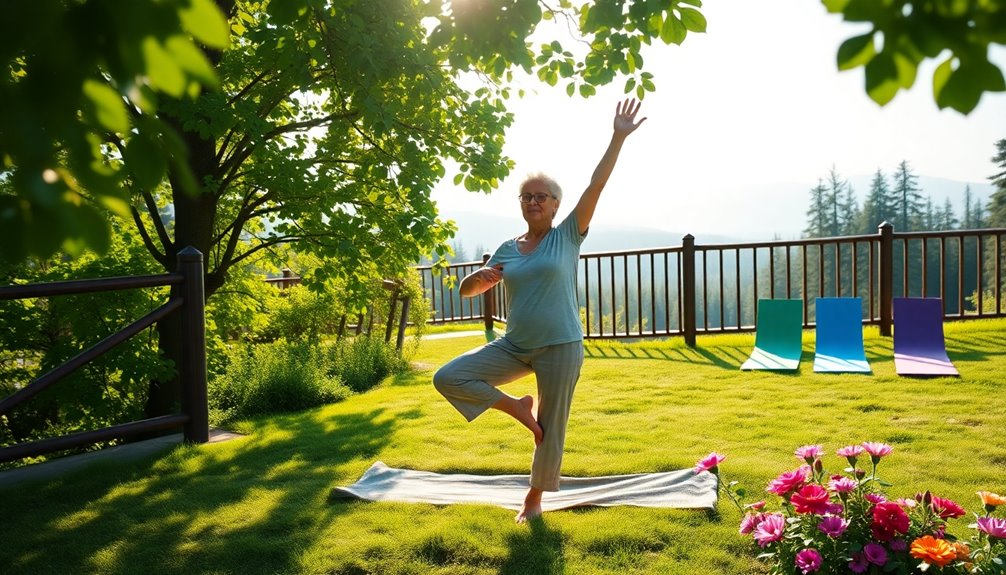To improve your balance and prevent falls, try these seven exercises: Sit-to-Stand, Standing Heel Raises, Single-Leg Balance, Heel-to-Toe Walk, Side Stepping, Backwards Walking, and Ankle Movements. Each exercise targets different muscle groups and enhances stability, helping you stay independent. Start slowly and increase difficulty as you gain strength. Incorporating these into your routine can greatly reduce your fall risk. Keep going, and you'll discover more valuable tips for enhancing your balance and mobility.
Key Takeaways
- Incorporate sit-to-stand exercises to enhance leg strength, crucial for preventing falls in older adults.
- Practice single-leg balance for stability improvement, gradually increasing the time held.
- Perform heel-to-toe walks to enhance balance and strengthen ankle and foot muscles.
- Engage in backward walking to boost coordination and overall stability.
- Regularly include dynamic stability exercises like heel-to-toe rocks to improve proprioception and body awareness.
Sit-to-Stand Exercise

When it comes to improving balance, the sit-to-stand exercise is a powerful tool you can easily incorporate into your routine. This exercise enhances leg strength, which is essential for preventing falls, especially in older adults.
To perform the sit-to-stand exercise, sit on a sturdy chair with your feet flat on the ground. Lean forward and shift your weight to stand up without using your hands for support. Aim for 10 repetitions twice a day to effectively enhance your strength and stability.
Before starting, it's wise to consult a doctor or physical therapist, particularly if you have any pre-existing health concerns. Regularly practicing this exercise can notably improve your body mechanics and balance, helping you stay safe and active.
Standing Heel Raises
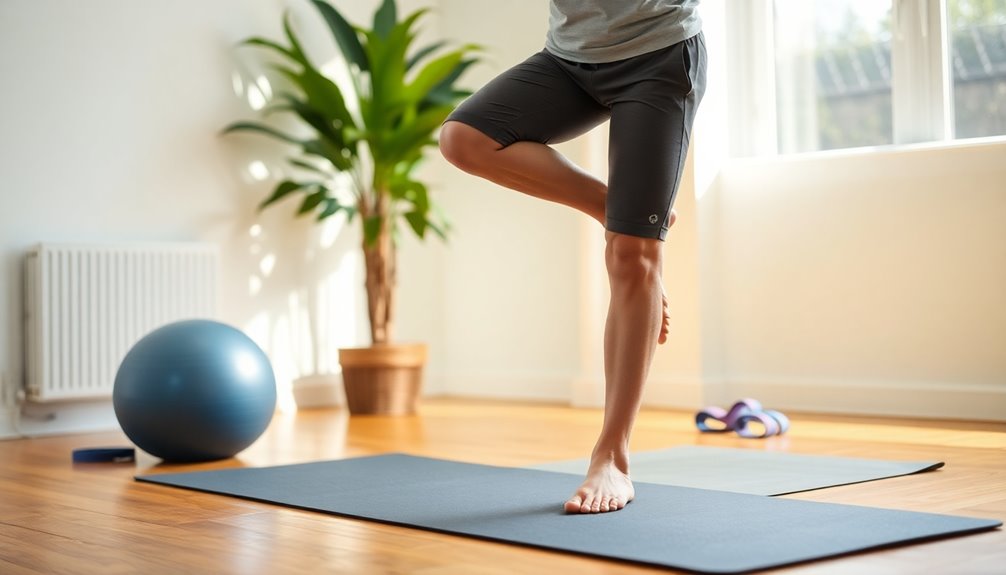
Standing heel raises are a simple yet effective way to boost your balance and stability.
By focusing on proper technique, you can maximize the benefits while reducing the risk of falls.
Let's explore how to incorporate this exercise into your routine for ideal results.
Benefits of Heel Raises
Heel raises offer a simple yet effective way to strengthen your calf muscles, which are essential for maintaining balance and stability, particularly as you age.
This exercise helps improve ankle stability and can greatly reduce the risk of falls. Here are three key benefits of incorporating heel raises into your routine:
- Strengthens Calf Muscles: Regular practice builds strength in your calves, important for maintaining balance.
- Enhances Proprioception: Heel raises improve your awareness of body position, which is critical for stability.
- Increases Ankle Flexibility: This exercise boosts flexibility, further supporting your overall balance.
Proper Technique Guidelines
To perform standing heel raises effectively, start by positioning your feet shoulder-width apart. Hold onto a sturdy chair or countertop for support to help improve balance. Slowly lift your heels off the ground, rising onto the balls of your feet while keeping your core engaged. Hold the position briefly before lowering your heels back down, ensuring controlled movements to prevent falls. Aim for two sets of 10 to 15 repetitions, gradually increasing as your muscle strength improves. Regularly incorporating these balance exercises into your routine can greatly enhance stability.
| Key Points | Technique Guidelines |
|---|---|
| Positioning | Feet shoulder-width apart |
| Support | Hold onto a sturdy chair |
| Movement Control | Lift heels slowly and lower with control |
Incorporating Into Routine
Incorporating standing heel raises into your daily routine can markedly boost your balance and stability.
These exercises help strengthen your leg muscles, which are essential for preventing falls.
Here's how to make the most of them:
- Stand on One Foot: Use a sturdy chair for support.
- Lift and Lower: Raise your heels off the ground, balancing on the balls of your feet, then lower them back down. Aim for 10-15 repetitions.
- Frequency: Perform these strength exercises at least twice a day, gradually increasing reps as you improve your balance.
Consistent practice of standing heel raises will enhance your overall stability and confidence while moving, ultimately helping you prevent falls and improve your balance.
Single-Leg Balance

One effective way to enhance your balance is through single-leg balance exercises. This exercise not only improves your stability but also helps strengthen your leg muscles, reducing your risk of falls.
Start by using a sturdy chair or countertop for support. Lift one leg off the floor and aim to hold for at least five seconds. As you gain confidence, gradually increase your hold time to 10 seconds or more.
Practicing this exercise for 30 seconds each leg is a good idea. Make sure you do this in a safe environment free of obstacles to minimize the fall risk.
Incorporating single-leg balance into your routine can greatly boost your overall balance and strength.
Heel-to-Toe Walk
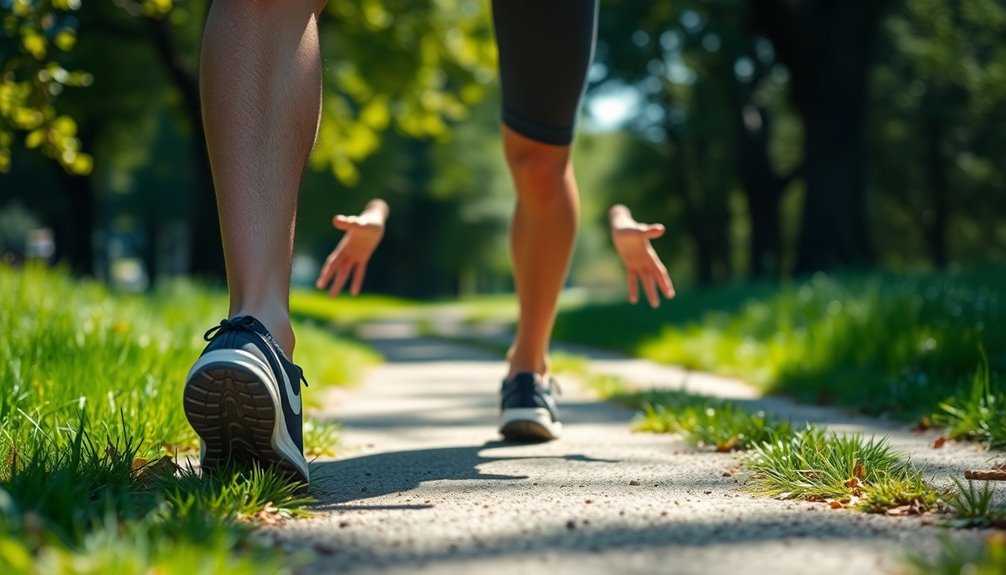
The Heel-to-Toe Walk is a straightforward exercise that focuses on your technique and form to enhance balance.
By walking in a straight line and ensuring each heel meets the toes of the opposite foot, you'll boost your stability with every step.
This simple practice can greatly reduce your risk of falls, especially as you age.
Technique and Form
A key component of the heel-to-toe walk exercise is mastering your technique and form to enhance balance effectively. This exercise can help prevent falling, especially for older adults.
To guarantee proper technique, follow these tips:
- Stand with your feet hip-width apart, then step forward, placing your heel directly in front of the toes of the other foot.
- Maintain a straight line as you walk 20 steps, ensuring each heel touches the toes of the foot in front.
- Wear supportive shoes and loose clothing for comfort and safety during your exercise program.
As you grow more confident, try this exercise without holding onto any support, which will further improve your balance and stability.
Benefits for Stability
Mastering technique and form in the heel-to-toe walk not only enhances your balance but also brings multiple benefits for stability.
This exercise requires you to align your heel directly in front of your toes, engaging your core and leg muscles, which helps improve stability and body awareness.
By regularly practicing the heel-to-toe walk, you strengthen your ankle and foot muscles, essential for maintaining strength and balance in daily activities.
Aim for at least 20 steps in a straight line, turning around to repeat the movement, which builds endurance and confidence.
Incorporating this physical activity into your routine can greatly reduce fall risk, especially for older adults, making it a crucial exercise for preventing falls.
Side Stepping
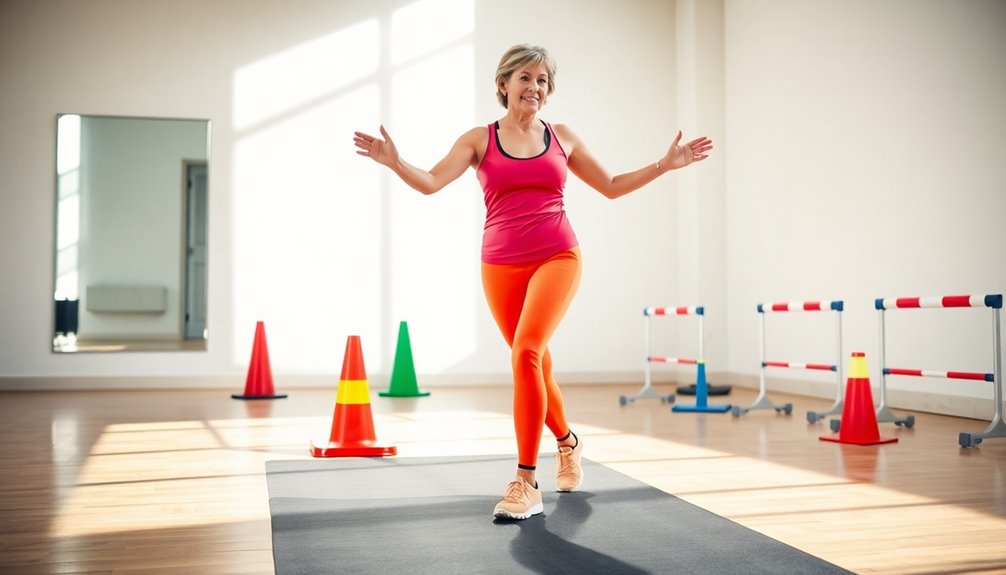
While side stepping may seem simple, it plays a vital role in enhancing lateral balance and stability, particularly for older adults. By regularly practicing this exercise, you can help prevent falls and feel confident in your movements.
Start in a mild squat with your feet apart, then step to the right, bringing your left foot beside your right. Aim for 10 steps to the right and repeat to the left.
Here are some tips to maximize your side stepping routine:
- Keep your eyes open to maintain awareness of your surroundings.
- Incorporate resistance bands to further build strength.
- Focus on fluid movements to enhance mobility and stability.
Regular side stepping can greatly improve your overall balance and independence.
Backwards Walking

Backwards walking is a powerful exercise that not only boosts your balance but also sharpens coordination and stability.
It's especially beneficial for older adults at risk of falls. To start, find a solid support like a wall or countertop until you build confidence.
Begin with small, controlled steps while looking over your shoulder to stay aware of your surroundings. Aim to complete 10 steps backward in each direction, gradually increasing your distance as your balance and strength improve.
Incorporating this exercise into your routine can enhance overall balance, strength, and proprioception, all significant elements for preventing falls.
With regular practice, you'll notice increased stability and coordination, making your everyday movements safer and more confident.
Ankle Movements
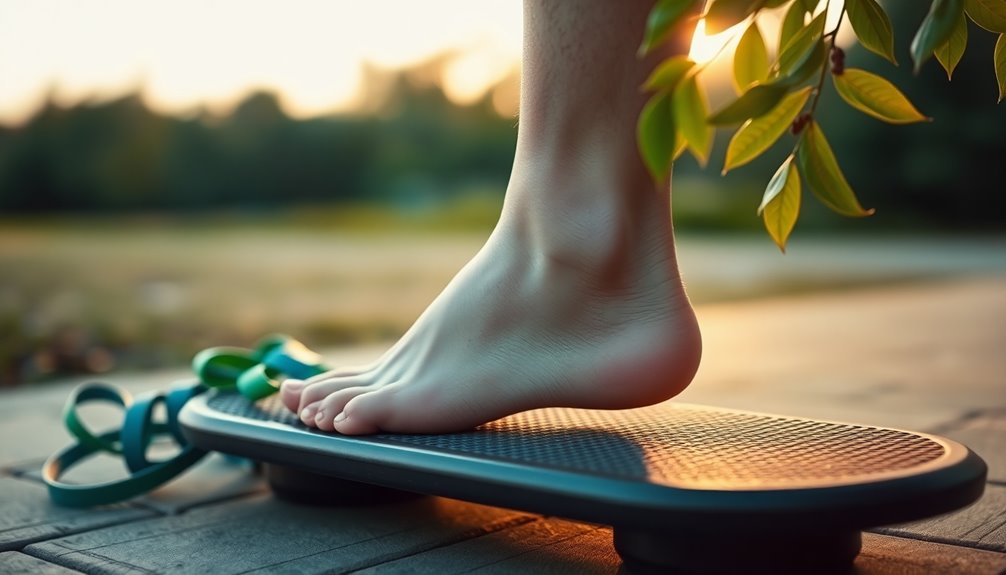
Ankle movements play an essential role in maintaining your flexibility and range of motion, critical for safely maneuvering uneven surfaces.
For older adults, these exercises are important in reducing fall risk. Here are three effective ankle movements you can incorporate into your routine:
- Toe Raises: Sit tall, lift one leg, and alternate pulling your toes towards your knee and pushing them away.
- Ankle Circles: While seated, extend your leg and make circles with your foot to enhance mobility.
- Heel-to-Toe Rocks: Stand and rock back and forth between your heels and toes to improve stability.
Frequently Asked Questions
What Is the Best Exercise to Prevent Falls?
When you're looking to prevent falls, you've got several effective exercises to choose from. A great option is the Sit-to-Stand exercise; it builds leg strength and enhances your balance.
Try doing 10 repetitions twice a day without using your hands for support. Additionally, incorporating balance exercises like standing on one leg or heel-to-toe walking can greatly improve your stability and coordination, making you less prone to falls.
What Are the 5 P's of Falls Prevention?
The 5 P's of falls prevention are:
Prioritize safety by recognizing potential hazards.
Plan your environment to reduce risks.
Practice strength and balance exercises.
Proper footwear to enhance stability.
Periodic medication reviews to identify any that might increase your fall risk.
What Is the Best Exercise for Improving Balance?
Imagine standing tall like a tree, roots firmly planted in the ground.
The best exercise for improving balance is standing on one leg. It challenges your stability and builds strength in your legs.
Start by holding onto a sturdy surface, then gradually let go as you find your center. Incorporate this into your routine, and you'll feel more grounded and confident in your movements, reducing your risk of falling over time.
How Do You Balance Exercises to Reduce Falls?
To balance exercises that reduce falls, you should mix strength and stability activities. Incorporate movements like sit-to-stand and single-leg stances into your routine.
Aim for two to three sessions each week, gradually increasing intensity as you improve. Always use sturdy support when starting out for safety.
Include dynamic activities like heel-to-toe walking to challenge your coordination.
Finally, track your progress and set small goals to stay motivated and committed to your practice.
Conclusion
So, while you might think balance is only for tightrope walkers and dancers, it's actually essential for everyone—even if you don't plan on performing in a circus anytime soon. By incorporating these exercises into your routine, you're not just avoiding the embarrassment of a slip and fall; you're also building strength and confidence. After all, who wouldn't want to impress their friends with their newfound stability? Start today, and you might just end up feeling like a graceful acrobat!
